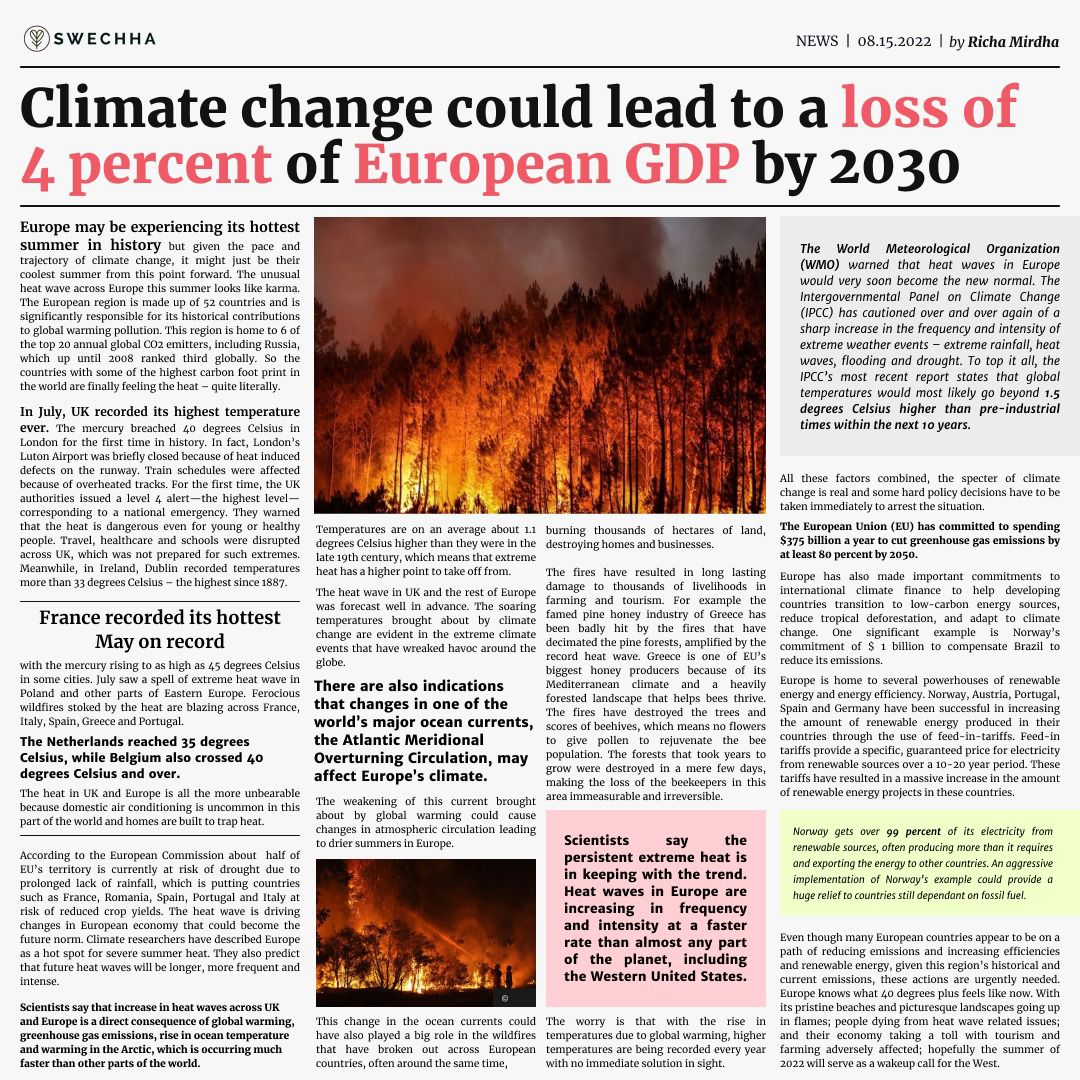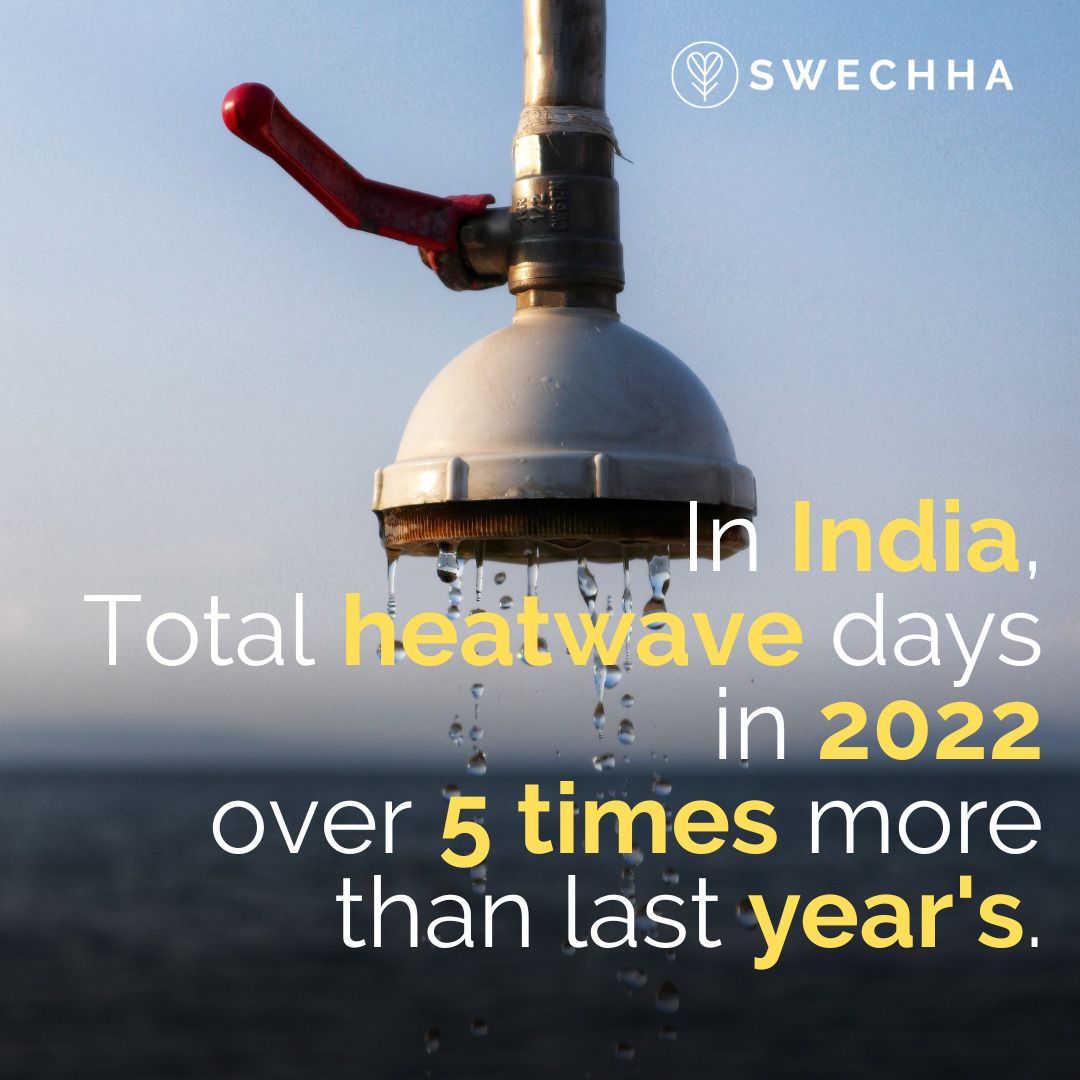climate change could lead to a loss of 4 percent
of European GDP by 2030
– by Richa Mirdha
Climate crisis in the UK and Europe: The scorching European Summer

Europe may be experiencing its hottest summer in history but given the pace and
trajectory of climate change, it might just be their coolest summer from this
point forward. The unusual heat wave across Europe this summer looks like karma.
The European region is made up of 52 countries and is significantly responsible
for its historical contributions to global warming pollution. This region is
home to 6 of the top 20 annual global CO2 emitters, including Russia, which up
until 2008 ranked third globally. So the countries with some of the highest
carbon foot print in the world are finally feeling the heat – quite literally.
In July, UK recorded its highest temperature ever. The mercury breached 40 degrees Celsius in London for the first time in history. In fact, London’s Luton Airport was briefly closed because of heat induced defects on the runway. Train schedules were affected because of overheated tracks. For the first time the UK authorities issued a level 4 alert—the highest level—corresponding to a national emergency. They warned that the heat is dangerous even for young or healthy people. Travel, healthcare and schools were disrupted across UK, which was not prepared for such extremes. Meanwhile, in Ireland, Dublin recorded temperatures more than 33 degrees Celsius – the highest since 1887.
Across the channel, France recorded its hottest May on record, with the mercury rising to as high as 45 degrees Celsius in some cities. July saw a spell of extreme heat wave in Poland and other parts of Eastern Europe. Ferocious wildfires stoked by the heat are blazing across France, Italy, Spain, Greece and Portugal. The Netherlands reached 35 degrees Celsius, while Belgium also crossed 40 degrees Celsius and over. The heat in UK and Europe is all the more unbearable because domestic air conditioning is uncommon in this part of the world and homes are built to trap heat.
According to the European Commission about half of EU’s territory is currently at risk of drought due to prolonged lack of rainfall, which is putting countries such as France, Romania, Spain, Portugal and Italy at risk of reduced crop yields. The heat wave is driving changes in European economy that could become the future norm. Climate researchers have described Europe as a hot spot for severe summer heat. They also predict that future heat waves will be longer, more frequent and intense. According to a 2021 European Central Bank report, climate change could lead to a loss of 4 percent of European GDP by 2030 in a worst-case scenario.

Scientists say that increase in heat waves across UK and Europe is a direct consequence of global warming, greenhouse gas emissions, rise in ocean temperature and warming in the Arctic, which is occurring much faster than other parts of the world. Temperatures are on an
average about 1.1 degrees Celsius higher than they were in the late 19th century, which means that extreme heat has a higher point to take off from.
The heat wave in UK and the rest of Europe was forecast well in advance. The soaring temperatures brought about by climate change are evident in the extreme climate events that have wreaked havoc around the globe. There are also indications that changes in one of the world’s major ocean currents, the Atlantic Meridional Overturning Circulation, may affect
Europe’s climate. The weakening of this current brought about by global warming could cause changes in atmospheric circulation leading to drier summers in Europe.

This change in the ocean currents could have also played a big role in the wildfires that have broken out across European countries, often around the same time, burning thousands of hectares of land, destroying homes and businesses. The fires have resulted in long lasting damage to thousands of livelihoods in farming and tourism. For example the famed pine honey industry of Greece has been badly hit by the fires that have decimated the pine forests, amplified by the record heat wave. Greece is one of EU’s biggest honey producers because of its Mediterranean climate and a heavily
forested landscape that helps bees thrive. The fires have destroyed the trees and scores of beehives, which means no flowers to give pollen to rejuvenate the bee population. The forests that took years to grow were destroyed in a mere few days, making the loss of the beekeepers in this area immeasurable and irreversible.
Scientists say the persistent extreme heat is in keeping with the trend. Heat waves in Europe are increasing in frequency and intensity at a faster rate than almost any part of the planet, including the Western United States. The worry is that with the rise in temperatures due to global
warming, higher temperatures are being recorded every year with no immediate solution in sight. The World Meteorological Organization (WMO) warned that heat waves in Europe would very
soon become the new normal. The Intergovernmental Panel on Climate Change (IPCC) has cautioned over and over again of a sharp increase in the frequency and intensity of extreme weather events – extreme rainfall, heat waves, flooding and drought. To top it all, the IPCC’s most recent report states that global temperatures would most likely go beyond 1.5 degrees Celsius higher than pre-industrial times within the next 10 years.
All these factors combined, the specter of climate change is real and some hard policy decisions have to be taken immediately to arrest the situation. The European Union (EU) has committed to
spending $375 billion a year to cut greenhouse gas emissions by at least 80 percent by 2050. Europe has also made important commitments to international climate finance to help developing countries transition to low-carbon energy sources, reduce tropical deforestation, and adapt to climate change. One significant example is Norway’s commitment of $ 1 billion to compensate Brazil to reduce its emissions. Europe is home to several powerhouses of renewable energy and energy efficiency. Norway, Austria, Portugal, Spain and Germany have been successful in increasing the amount of renewable energy produced in their countries through the use of feed-in-tariffs. Feed-in tariffs provide a specific, guaranteed price for electricity from renewable sources over a 10-20 year period. These tariffs have resulted in a massive increase in the amount of renewable energy projects in these countries.
Norway gets over 99 percent of its electricity from renewable sources, often producing more than it requires and exporting the energy to other countries. An aggressive implementation of Norway’s example could provide a huge relief to countries still dependant on fossil fuel.
Even though many European countries appear to be on a path of reducing emissions and increasing efficiencies and renewable energy, given this region’s historical and current emissions, these actions are urgently needed. Europe knows what 40 degrees plus feels like now. With its pristine beaches and picturesque landscapes going up in flames; people dying from heat wave related issues; and their economy taking a toll with tourism and farming adversely affected; hopefully the summer of 2022 will serve as a wakeup call for the West.
Research Credit:
The New York Times
Climatehotmap.org
BBC
Reuters

